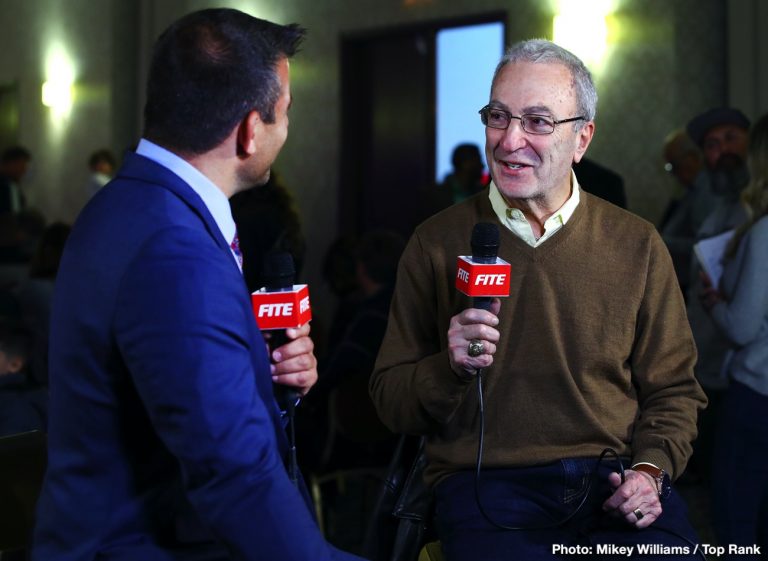At the recent PAB HOF Banquet, I asked IBHOF promoter J Russell Peltz to do something on Philly boxing, and here goes:
KH: “How has your response been to your book, ‘THIRTY DOLLARS and A CUT EYE’?”
JR: “Terrific. Great reviews on Amazon. Everyone seemed to love it. It’s very satisfying for a self-published boxing book. Have sold a tad under 1,800 copies as of today and should pass that next week.”
KH: “Russell, did you have a favorite Philly promoter when you first started promoting as a young student at Temple University?”
JR: “I had graduated from Temple when I began promoting one year later. Graduated in June 1968, the first card was in September 1969. Did not have a favorite promoter. Lou Lucchese was the busiest promoter in Philly in the 1960s, but Herman Taylor still was the Dean.”
KH: “There are several Philly boxers you have spoken well of, such as Light Heavyweight champion Harold Johnson, whom you called your “My Boyhood Idol,” and I, myself, did my first article on him.”
JR: “One of boxing’s most underrated fighters. 76-11 record with four losses to Archie Moore (he beat Moore one). He also beat Bob Satterfield twice (avenging one loss), Ezzard Charles, Nino Valdes, Eddie Machen, and Doug Jones, whom he beat in 1962 for the undisputed title.
“Defended in Germany against a German, Gustav Scholz, who had lost only once in 92 fights. Harold won by decision with all three judges (including the ref) from Europe in an outdoor soccer stadium in front of 40,000 Germans.
“Who would do that today? In a previous title defense (NBA variety), he won a 15-round decision over Eddie Cotton in Cotton’s backyard in Seattle, WA.
“All three officials (ref voted) were from Washington State. Who does that today? Another was a Philly favorite in ‘Bad’ Bennie Briscoe, whom you referred to as “Bennie Briscoe made me!”
JR: “My book is about my 50 years in boxing. Without getting Bennie after the first year, my book would have been about 50 weeks in boxing. He was the most popular fighter in Philly in the 1970s and always drew big crowds and made great fights.”
“He was my “stopper.” In baseball in the 1960s, when the LA Dodgers would lose a couple of games, they could always count on Sandy Koufax to end the losing streak. He was their “stopper.
“If we would lose money on a couple of shows, there always was Bennie’s next fight to turn things around, so he was my “stopper.” He was the symbol of Philly boxing during the last Golden Age of boxing in Philly.”
KH: “What was your favorite facility to hold your promotions?”
JR: “Certainly, the Blue Horizon for its intimacy, but even though we thought the Arena in West Philly (46th & Market) was passé, I would have loved another chance to run there. It, too, was perfect for boxing, 7,000 seats.”
KH: “The worst decision I ever saw was in Philly when Tyrone Everett lost to Alfredo Escalera. What were your thoughts on that fight? You wrote, “I could write about all the characters who helped to arrange for that putrid decision, but there are lawyers around who could sue me.”
JR: “The decision was fixed. The readers will have to buy the book.”
KH: “Besides Philly and New Jersey what other places did you promote along with other countries?”
JR: “Tyndall Armory and Market Square Arena in Indianapolis, IN; Foxwoods Casino in Mashantucket, CT; Casino Ballroom in Hampton Beach, NH; Silver Star Casino in Choctaw, Mississippi Dover (DE) Downs Casino; Fournier Hall in Wilmington, DE. I’m sure there were others.”
KH: “What were your thoughts on ‘Bad’ Bennie Briscoe in his first fight, the draw in Argentina with future champion Carlos Monzon?
JR: “I wasn’t with Bennie then, and I do not know if there is any video of that fight.”
KH: “Who do you think was the hardest hitter from Philly?”
JR: “For one punch, Eugene “Cyclone” Hart’s left hook was the hardest and quickest I’ve ever seen live.”
KH: “Besides being an IBHOF promoter, you also did matchmaking for other promoters. Can you name some of them you worked for?”
JR: “Top Rank; Banner Promotions; Main Events (Dan/Kathy Duva).”
KH: “Who do you rank as the best pound-for-pound boxer of all time?”
JR: “No one did it better than Sugar Ray Robinson.”
KH: “Who do you think was Philly’s best boxer of all time?”
JR: “Joe Frazier is the best known, but light-heavyweight Tommy Loughran (who couldn’t punch hard) may have the best resume.
KH: “What are your thoughts on boxing today compared to the 60’s through the 80’s?”
JR: “Boxing is more business than sport. A possibility of 68 champions in 17 weight classes. There are five weight classes from 105 to 118. There’s a possibility of four champions every 3.6 pounds.
“Before this mess started with the four sanctioning bodies, we had two world champions in that grouping, 112 and 118 pounds. Now we have the possibility of 20 world champions within 13 pounds of each other. That’s a joke.
“Why don’t we just have four world champions for every pound on the scale because it seems like that’s where we are headed. And everyone wants to be undefeated, which is why it’s so tough to make competitive matches at every level, and that’s why I no longer promote. Boxing is out of control.
“There always will be big fights here and there, but boxing’s middle class is dead. 95% of the money in boxing is controlled by 5% of the people.
“The other 5% of the money in boxing is for the other 95% of the people in it. I hope it can go back to the way it once was. All I can do is hope.”
KH: “I want to thank you for taking the time to answer these questions.”
JR: “My pleasure, as usual, Ken Hissner.”

